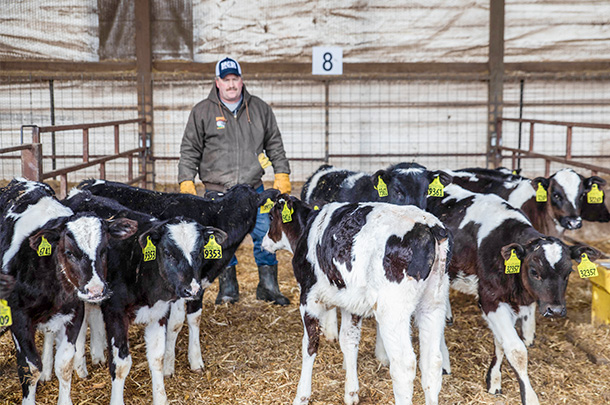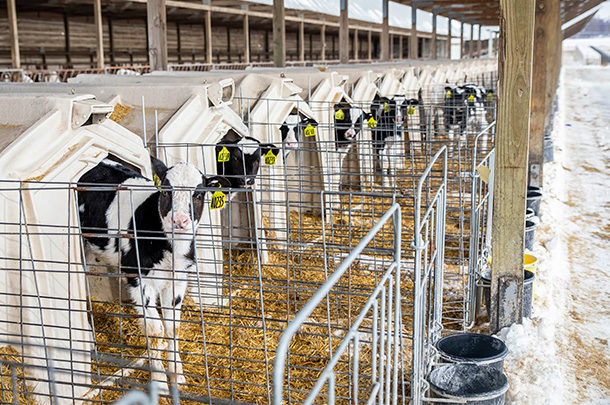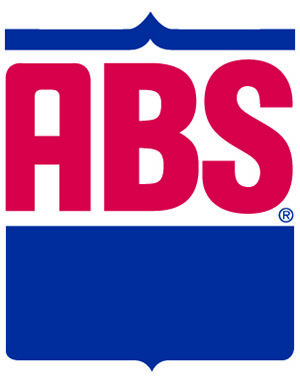The practice of raising young stock off-site has grown among large dairies over the years. In 2014, 62.8% of large operations sent replacement heifers to an off-site raising facility as pre-weaned calves, according to a USDA report.
This change in rearing may result in the unintended consequence of reintroducing pathogens assumed to be under control back into the farm, especially since replacement heifers are often comingled with animals from multiple dairy operations and geographical locations. If your heifers are raised off-site, only contract with calf/heifer growers who follow consistent, carefully planned pre- and post-arrival protocols that include biosecurity measures to better protect your home operation.
 Photo courtesy of Merck Animal Health.
Photo courtesy of Merck Animal Health.Case study
J. Hall has been raising calves since he was five years old on his family’s dairy farm in Michigan. Today, at Hall’s Calf Ranch in Luxemburg, Wisconsin, 8,500 calves populate his facility on any given day with another 1,000 calves at a secondary facility in Gladwin, Michigan.
Most calves enter the facilities at 12-24 hours old and are raised in hutches until they’re off milk. To optimize health, Hall has strict requirements for the calves he receives. “Before we pick up a calf, we ask that it was given at least a gallon of colostrum, had its navel dipped, been ear-tagged and kept in a clean, dry place,” Hall says. “We also want that calf to have been given an intranasal vaccine for IBR, BRSV and PI3 protection.” (IBR – infectious bovine rhinotracheitis; BRSV – bovine respiratory syncytial virus; PI3 – parainfluenza-3).
Pre-arrival processing protocols
Since establishing pre-arrival health protocols for his dairy producers, and clearly communicating the reasons behind his recommendations, Hall has observed stronger, healthier and more vigorous calves delivered to his operation. He has also experienced fewer respiratory and scours issues. He recommends the following to his customers:
-
Environment and colostrum management: Hall’s most critical pre-arrival recommendations to his customers include prioritizing the cleanliness of the environment the calf is born into and that each calf receives enough high-quality colostrum.
-
Strategic vaccination: Hall believes that care and management begins several weeks before the calf is born, emphasizing the importance of the pre-partum environment. Additional management practices include strategic vaccinations that positively impact calf health. He urges customers to administer a scours vaccine to late-gestation dams and asks that each calf receive an intranasal three-way viral respiratory vaccine post-calving.
-
Navel dip: Hall’s requirement is to dip the navel shortly after birth with a 7% tincture of iodine to help reduce the risks of navel and joint infections, as well as bacterial pneumonia.
- Tagging: Ear tags should be placed prior to arrival to identify the calf for health monitoring purposes, to record age and to link the calf to the farm of origin.
 Photo courtesy of Merck Animal Health.
Photo courtesy of Merck Animal Health.Post-arrival management protocols
Once calves are delivered to Hall’s Calf Ranch, Hall says, “We inspect them, weigh them, then put them in a clean, dry pen and feed them. The next morning, we will pull blood and do a serum protein test. That tells us how much colostrum the calf has received. We also send a blood sample away for a [bovine viral diarrhea-parainfluenza] BVD-PI test. Very rarely does any calf test positive.”
Hall’s post-arrival protocols focus on efforts to minimize disease risks in the calves under his care. They include the following:
-
Inspection: Calves are observed visually for signs of disease and are provided treatment and rehydration as needed. Navels are inspected and re-dipped. Calves that do not pass inspection may be rejected.
-
Weight: Calf weight is recorded on arrival as a benchmark to monitor growth and performance.
-
Environment: Hutches and feeding equipment are cleaned and sanitized prior to new calf entry.
-
Blood draw: Serum total proteins are measured on each calf to assess colostral intake. In addition, all animals are screened to determine if they are persistently infected with BVD as part of an overall BVD biosecurity strategy.
- Vaccination: At 3 days old, all calves receive a coronavirus vaccine. At 6 weeks old, a second coronavirus vaccine is administered along with an SQ combination vaccine that provides viral (IBR, BRSV, PI3) and bacterial (Mannheimia haemolytica) respiratory protection. At 9 weeks old, prior to the move to group housing, all calves receive a second intranasal vaccine for IBR, BRSV, PI3, M. haemolytica and Pasteurella multocida to further reduce respiratory disease risk.
 Photo courtesy of Merck Animal Health.
Photo courtesy of Merck Animal Health.Hall adds, “We booster with an intranasal vaccine with viral and bacterial pneumonia protection when we move calves from hutches to the barn at 9 weeks old. That’s a stress point when we move them, so we give it again. They don’t even notice that you’ve given it to them. It’s very calm and smooth.”
When it comes to trying new vaccine products, Hall recommends that producers do a trial to see what works best. “Try it on 20 calves or 100 calves, depending on the size of your operation, and see how it works for you.”
Consult your veterinarian
Hall works closely with two veterinarians who consult on his herd health program and vaccination decisions, and he relies on his trusted staff personnel to carry out their recommended procedures. “We watch the calves – they’ll show us what they need,” explains Hall. “We take that information to the veterinarians, who bring the science to it. We try to mix science and the actual visuals of what the calves need.”







